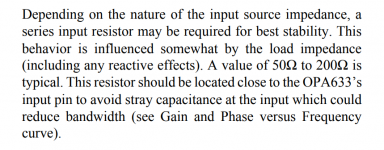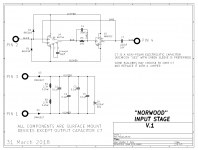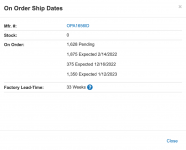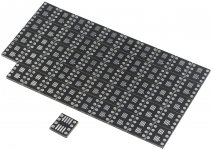@johnc124
The circuit in this thread, OPA1656 Phono Preamp: Split from OPA1656 thread , clearly has a negative real part of its input impedance at high frequencies. Can that also happen with an OPA1656 voltage follower (that's what it is at high frequencies) when the board layout is perfect, or does it require a less than ideal layout for that?
The circuit in this thread, OPA1656 Phono Preamp: Split from OPA1656 thread , clearly has a negative real part of its input impedance at high frequencies. Can that also happen with an OPA1656 voltage follower (that's what it is at high frequencies) when the board layout is perfect, or does it require a less than ideal layout for that?
I think the answer to the first part of my question is yes for just about any op-amp, see https://www.diyaudio.com/forums/ana...eamp-split-opa1656-thread-18.html#post6795387
Marcel - Still no answer From John..?
A little detail I forgot all about is that all of the 1656 output scope shots I published were not of the real output. There was always that 59KHz passive low-pass RC filter between the 1656 and the RCA Out. I'm guessing that those pics are a rounded version of what really went on at pin 1 or pin 7.
A little detail I forgot all about is that all of the 1656 output scope shots I published were not of the real output. There was always that 59KHz passive low-pass RC filter between the 1656 and the RCA Out. I'm guessing that those pics are a rounded version of what really went on at pin 1 or pin 7.
Indeed no answer from John, neither on this nor on the split thread. So far I'm the only one who answered my question.
By the way, you did mention at least once that you measured after the passive low-pass at the output.
By the way, you did mention at least once that you measured after the passive low-pass at the output.
I should have clipped onto the output jumper or the 330R. Might have made for an even more dramatic show. Oh well.
In perhaps different terms what is it you are asking John about so that I might get the gist?
In perhaps different terms what is it you are asking John about so that I might get the gist?
I was just wondering whether one can get the kind of problem you had when the op-amp is mounted on a perfect PCB. That is, op-amp datasheets always warn you about capacitive loads, but should they also warn about inductive and resonant sources?
Based on my calculation, I think the answer is yes, not just for the OPA1656 but for any op-amp, particularly the fast ones.
Based on my calculation, I think the answer is yes, not just for the OPA1656 but for any op-amp, particularly the fast ones.
Last edited:
Check the datasheets of the LMH6321 and also the OPA633. Both of them recommend a resistor in series with the input pin; example verbiage below.
That's why I included resistor R3 in the "Norwood" circuit, sold by the diyAudio Store as part of the M2x bundle. Capacitor C4 was included because I read section 6.6 of the LMH6321 datasheet, and decided to apply its recommendations. However, some phono preamps (e.g. Parasound JC-2) omit this capacitor and accept the bandwidth reduction since multi-megahertz isn't in the job description for an RIAA equalizer. Instead, these phonostage circuits connect an inductor in parallel with the series resistor, to mitigate its Johnson-Nyquist noise contribution in the audio band.
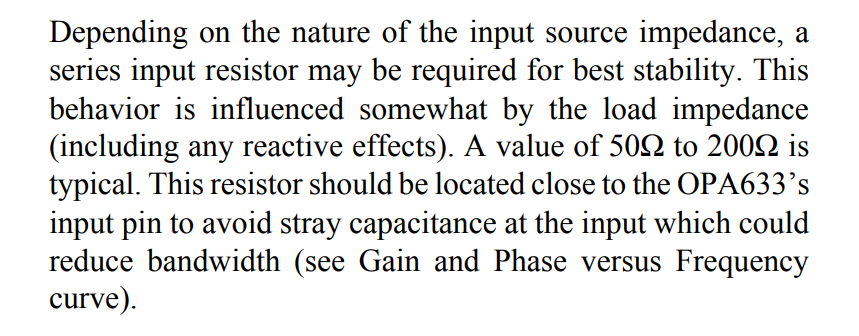
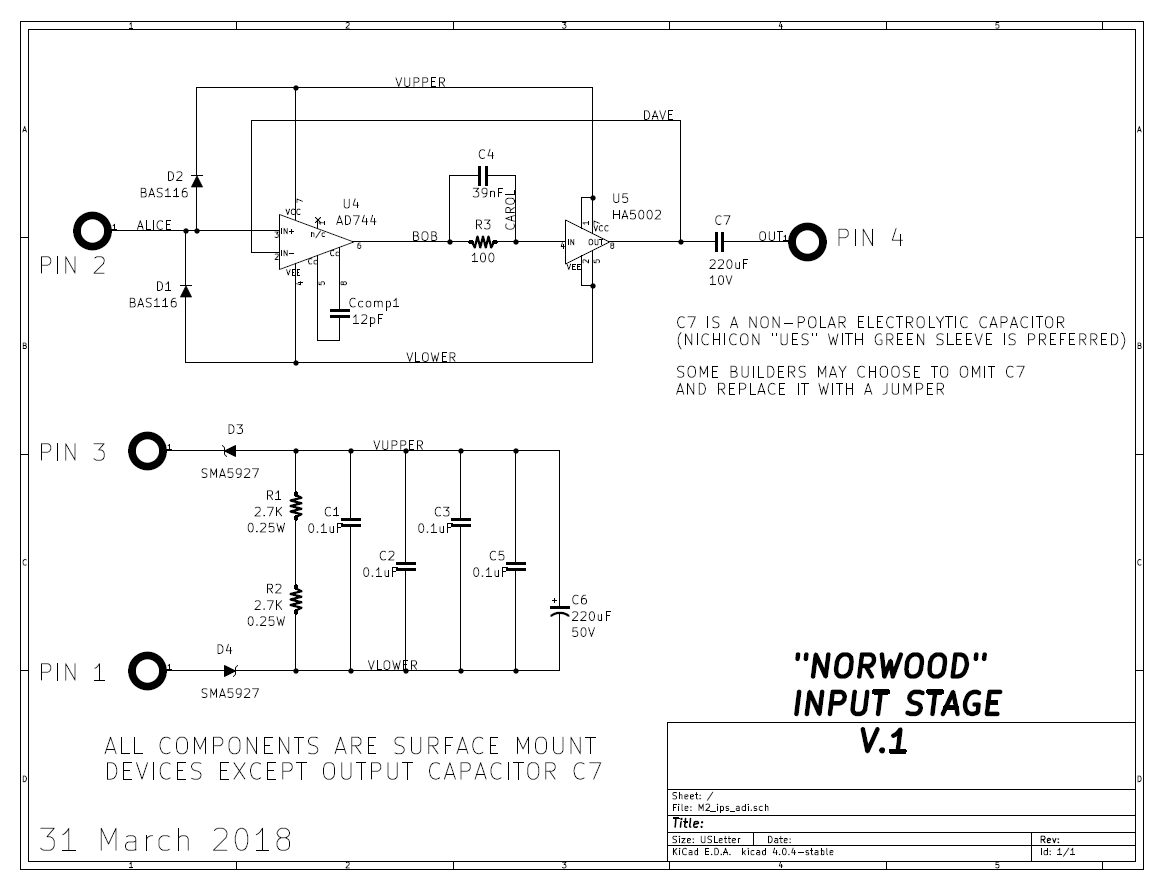
_
That's why I included resistor R3 in the "Norwood" circuit, sold by the diyAudio Store as part of the M2x bundle. Capacitor C4 was included because I read section 6.6 of the LMH6321 datasheet, and decided to apply its recommendations. However, some phono preamps (e.g. Parasound JC-2) omit this capacitor and accept the bandwidth reduction since multi-megahertz isn't in the job description for an RIAA equalizer. Instead, these phonostage circuits connect an inductor in parallel with the series resistor, to mitigate its Johnson-Nyquist noise contribution in the audio band.
_
Attachments
Last edited:
In a old audio express phono amp article by Dennis Colin he mentions the only way to tame the ad797 was to put a small r (221?) in series with the input pin
Member Syn08 improved on the circuit I’d have to look to see if he did the same, but iirc he did not use the ad797
Member Syn08 improved on the circuit I’d have to look to see if he did the same, but iirc he did not use the ad797
After a long listening comparison over months with a number of modern audio OP-Amps, I can only say that the OPA1656 is one of the best integrated in terms of sound. With this, TI has achieved a great success. I've never tried discrete solutions like Burson. If you place more value on the acoustic end result, instead of endlessly philosophizing about technical parameters and the resulting best place of application, you should just try the 1656! For me it was worth it. ;-)
Unobtanium?
I finally got around to starting a project with the OPA1656. Last month, Mouser had 0 stock, but Digikey had some. When I checked just now, Digikey was out.
Mouser is showing a lead time of about 4 months (screenshot).
I checked the TI Store and they had 3(!), so I placed an order. I did get a confirmation email, so we'll if they show up. 😀
Sigh...
I finally got around to starting a project with the OPA1656. Last month, Mouser had 0 stock, but Digikey had some. When I checked just now, Digikey was out.
Mouser is showing a lead time of about 4 months (screenshot).
I checked the TI Store and they had 3(!), so I placed an order. I did get a confirmation email, so we'll if they show up. 😀
Sigh...
Attachments
The OPA1656 pre-mounted to a DIP8 adapter for $14 is here:
SOIC-8 to 8-pin DIP Adapter - 970601 - Cimarron Technology
And the SOIC-8 by itself for $2.99
OPA1656IDR Texas Instruments - Cimarron Technology
I've purchased several flavors of double singles and duals mounted to DIP8 adapters and they do beautiful work.
SOIC-8 to 8-pin DIP Adapter - 970601 - Cimarron Technology
And the SOIC-8 by itself for $2.99
OPA1656IDR Texas Instruments - Cimarron Technology
I've purchased several flavors of double singles and duals mounted to DIP8 adapters and they do beautiful work.
If you want to start at the top of the heap, want to sleep at night and can pony-up the $$ this is the one from way back:
Single-to-dual Op-Amp Adapter - 020302 - Cimarron Technology
IMHO - but research the OPA627 and the OPA2107 DiFETs.
Single-to-dual Op-Amp Adapter - 020302 - Cimarron Technology
IMHO - but research the OPA627 and the OPA2107 DiFETs.
Shop around, you never know, but only use reputable TI distributors
The first one I try, Arrow has >3k, iirc cheaper than what I paid at mouser
The first one I try, Arrow has >3k, iirc cheaper than what I paid at mouser
Last edited:
Thanks for the suggestions - I always try Mouser and Digikey first since I buy a lot of stuff from them. Have not used Arrow in years. Cimarron is new to me. There are some suspicious offers on eBay from China. What was pretty amazing was that TI had only 3 in stock.
As far as adapters, I have a panel of these and lots of pin headers I solder on myself (yes I am cheap 😀)
As far as adapters, I have a panel of these and lots of pin headers I solder on myself (yes I am cheap 😀)
Attachments
Last edited:
Others may have other ideas especially if they have a broader knowledge of what’s out there in TI-land, what AD has to offer and/or legacy/older op amps. But MHO is that if you want a 1656 single, spec-wise the OPA627 single (unity gain stable) and its faster sibling the OPA637 (gains ≥ 5) come real close to or better the much newer OPA1656 dual. Compare them on paper for yourself as to what features or parameters are most important to your design.
FWIW, I’m biased towards sound quality, very low input bias current, low input voltage noise, and very low offset voltage a la the 1656. If this is an audio project, close your eyes and just get the 627 or the 637 depending on the gain needed. At least when I’ve done searches on “best op amp for audio” the OPA627/637 are on or near top shelf in the opinion of those DIYers who listen to many. Not much yet on the 1656 as an audio amp.
The 627/37 con is that they are expensive. The TI Store still has stock of the DIP-8 and the SOIC. Cimarron Technologies can mount one single SOIC on a DIP-8 adapter. Just ask. They have quite a stable of newer and older single and duals they offer in native SOIC or can mount on DIP-8 adapters. But for example two 627 singles mounted to a dual DIP-8 is $66 whereas one dual 1656 on a DIP-8 is $14.
FWIW, I’m biased towards sound quality, very low input bias current, low input voltage noise, and very low offset voltage a la the 1656. If this is an audio project, close your eyes and just get the 627 or the 637 depending on the gain needed. At least when I’ve done searches on “best op amp for audio” the OPA627/637 are on or near top shelf in the opinion of those DIYers who listen to many. Not much yet on the 1656 as an audio amp.
The 627/37 con is that they are expensive. The TI Store still has stock of the DIP-8 and the SOIC. Cimarron Technologies can mount one single SOIC on a DIP-8 adapter. Just ask. They have quite a stable of newer and older single and duals they offer in native SOIC or can mount on DIP-8 adapters. But for example two 627 singles mounted to a dual DIP-8 is $66 whereas one dual 1656 on a DIP-8 is $14.
^If you say OPA627 , check out next gen OPA828 . It's still affordable bought from the TI store.
Not many reviews so far though.
Not many reviews so far though.
- Home
- Vendor's Bazaar
- OPA1656: High-Performance CMOS Audio Op Amp
